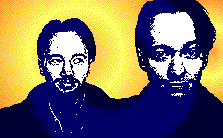

The Digestion of an American Myth
by Grant L. Allen
 The distortion
that a sign suffers as it crosses over into myth is paradoxical in that the
original idea is simultaneously reduced and enlarged. In Myth Today Roland
Barthes writes, "Myth is speech stolen and restored," but when it
is restored, we find that the distortion that it has undergone results in its
being both more and less than it was before it became a myth.
The distortion
that a sign suffers as it crosses over into myth is paradoxical in that the
original idea is simultaneously reduced and enlarged. In Myth Today Roland
Barthes writes, "Myth is speech stolen and restored," but when it
is restored, we find that the distortion that it has undergone results in its
being both more and less than it was before it became a myth.
The original sign (signifier and signified)
is enlarged partially because of its very status as a myth; It achieves a new
and wider acceptance in the social consciousness. At the same time, as the result
of its traveling through the "language machine," an original, often
complex concept is reduced into a single signifier. This signifier comes to
represent a concept that, previous to its becoming a myth, had to be experienced
or explained at length in order to be understood. To a large extent the original
concept is devoured by society and the end product is, if I pursue this metaphor,
linguistic excrement. I use this description because in many cases complex ideas
are reduced to a single word or catch phrase that becomes practically meaningless
in its attempt to encompass a much larger group of ideas than a single sign
is able to support. As the price for its acceptance into the mass mind something
essential is invariably lost. The dull tool that is language is blunted further.
In some situations people end up arguing over something they fundamentally agree
upon simply because they define their words differently. The creation of myth
magnifies this problem.
 The mythic
sign is like a jigsaw puzzle piece that must be made to fit into the enormous
puzzle of language that is passed to us through history; That piece never seems
to fit in its original form. Society, in its attempt to make this new piece
fit, is invariably forced to trim and add to the piece here and there in an
attempt to make it fit into the larger framework of language. In becoming a
part of this framework the new myth takes on a new importance while at the same
time losing part of itself. As it is assimilated the original idea is in many
ways reduced to the lowest common denominator of society's language. Society's
only way of understanding a new idea is through its existing language, complete
with all of its old assumptions and underlying ideologies. I will use the myth
of the "beatnik" to illustrate this process, because I feel that during
the Fifties the "beat" idea was devoured by society and excreted as
the beatnik myth.
The mythic
sign is like a jigsaw puzzle piece that must be made to fit into the enormous
puzzle of language that is passed to us through history; That piece never seems
to fit in its original form. Society, in its attempt to make this new piece
fit, is invariably forced to trim and add to the piece here and there in an
attempt to make it fit into the larger framework of language. In becoming a
part of this framework the new myth takes on a new importance while at the same
time losing part of itself. As it is assimilated the original idea is in many
ways reduced to the lowest common denominator of society's language. Society's
only way of understanding a new idea is through its existing language, complete
with all of its old assumptions and underlying ideologies. I will use the myth
of the "beatnik" to illustrate this process, because I feel that during
the Fifties the "beat" idea was devoured by society and excreted as
the beatnik myth.
 "Beat"
as it refers to an idea and a generation, was a word first coined by Jack Kerouac
at the beginning of the fifties. It produced icons that run the gamut from Dean
Moriarty, the protagonist of Kerouac's novel On the Road, to Dobie Gillis'
goateed sidekick Maynard G. Krebs. In the distance between Dean and Maynard
we can witness the incredible distortive effect that myth has on reality. These
icons represent, to some extent, the difference between the "beats"
as they knew themselves and the "beatniks" as they were defined and
translated into myth by a Fifties mind set. A large part of the distortion that
the "beats" suffered was due to their intentional opposition to the
conformist consumer nature of 1950s America. Mainstream society's attempts to
understand the "beats" was, in many ways, its attempt to fit a round
peg in a "square" hole. It appears, in retrospect, that "understanding"
was not what a large part of the population was attempting. Ignoring Kerouac's
attempts to define the "beat" ideal as a quest for joy in a decade
of cold war and McCarthy, the media was quick to attach many of what society
considered sins to the "beats."
"Beat"
as it refers to an idea and a generation, was a word first coined by Jack Kerouac
at the beginning of the fifties. It produced icons that run the gamut from Dean
Moriarty, the protagonist of Kerouac's novel On the Road, to Dobie Gillis'
goateed sidekick Maynard G. Krebs. In the distance between Dean and Maynard
we can witness the incredible distortive effect that myth has on reality. These
icons represent, to some extent, the difference between the "beats"
as they knew themselves and the "beatniks" as they were defined and
translated into myth by a Fifties mind set. A large part of the distortion that
the "beats" suffered was due to their intentional opposition to the
conformist consumer nature of 1950s America. Mainstream society's attempts to
understand the "beats" was, in many ways, its attempt to fit a round
peg in a "square" hole. It appears, in retrospect, that "understanding"
was not what a large part of the population was attempting. Ignoring Kerouac's
attempts to define the "beat" ideal as a quest for joy in a decade
of cold war and McCarthy, the media was quick to attach many of what society
considered sins to the "beats."
 The original
idea of what it meant to be "beat" was simultaneously enlarged and
reduced by its passage into myth. It was enlarged in that it introduced American
society at large to previously seldom heard of topics such as marijuana and
Zen Buddhism. It helped bring bebop jazz as played by
great black musicians like Charlie "Bird" Parker to a larger audience
as well as bringing poetry into a modern setting. The myth of the beatnik set
the stage for the bohemian and counter culture movements of later decades.
The original
idea of what it meant to be "beat" was simultaneously enlarged and
reduced by its passage into myth. It was enlarged in that it introduced American
society at large to previously seldom heard of topics such as marijuana and
Zen Buddhism. It helped bring bebop jazz as played by
great black musicians like Charlie "Bird" Parker to a larger audience
as well as bringing poetry into a modern setting. The myth of the beatnik set
the stage for the bohemian and counter culture movements of later decades.
At the same time,
"beat" lost its original, intended meaning. Society came to regard
the beatnik as unwashed, lazy, immature and in some cases dangerous and perverted.
Beatniks became confused with Blackboard Jungle type juvenile delinquents
and were portrayed as such in several violent exploitation films such as The
Beat Generation and The Wild Party. In their myth making role, Hollywood
films seldom seem to get it right. The "beats" by their very nature
didn't fit into mainstream society and as a result they were devoured by the
existing ideology.
 The transition
from beat idea to beatnik myth distorted the original almost beyond recognition.
The "beat" lost his or her identity and became, to some extent, a
cartoon character, a stereotype; Today, many peoples' concept of what is "beat"
is based entirely on Maynard G. Krebs, bongos, turtleneck sweaters, and berets.
At the same time, the creation of a myth gave the movement a larger audience,
introduced a larger section of society to some new ideas and provided a much
needed counterpoint to "square" society. By expanding the American
Underground, it helped set the ideological stage for bohemian and counter culture
movements of the Sixties and Seventies. Another positive aspect of the beatnik
myth is that it forced the "beats" themselves to reexamine their ideas,
to evolve and to move on ideologically. Hopefully the "beat's" transition
into myth will not cause us to forget or lose touch with the questions asked
and lessons learned by the "beat generation."
The transition
from beat idea to beatnik myth distorted the original almost beyond recognition.
The "beat" lost his or her identity and became, to some extent, a
cartoon character, a stereotype; Today, many peoples' concept of what is "beat"
is based entirely on Maynard G. Krebs, bongos, turtleneck sweaters, and berets.
At the same time, the creation of a myth gave the movement a larger audience,
introduced a larger section of society to some new ideas and provided a much
needed counterpoint to "square" society. By expanding the American
Underground, it helped set the ideological stage for bohemian and counter culture
movements of the Sixties and Seventies. Another positive aspect of the beatnik
myth is that it forced the "beats" themselves to reexamine their ideas,
to evolve and to move on ideologically. Hopefully the "beat's" transition
into myth will not cause us to forget or lose touch with the questions asked
and lessons learned by the "beat generation."
© 2000 Grant L. Allen &
Chuck T. Alien Contact Us!




 The distortion
that a sign suffers as it crosses over into myth is paradoxical in that the
original idea is simultaneously reduced and enlarged. In Myth Today Roland
Barthes writes, "Myth is speech stolen and restored," but when it
is restored, we find that the distortion that it has undergone results in its
being both more and less than it was before it became a myth.
The distortion
that a sign suffers as it crosses over into myth is paradoxical in that the
original idea is simultaneously reduced and enlarged. In Myth Today Roland
Barthes writes, "Myth is speech stolen and restored," but when it
is restored, we find that the distortion that it has undergone results in its
being both more and less than it was before it became a myth. The mythic
sign is like a jigsaw puzzle piece that must be made to fit into the enormous
puzzle of language that is passed to us through history; That piece never seems
to fit in its original form. Society, in its attempt to make this new piece
fit, is invariably forced to trim and add to the piece here and there in an
attempt to make it fit into the larger framework of language. In becoming a
part of this framework the new myth takes on a new importance while at the same
time losing part of itself. As it is assimilated the original idea is in many
ways reduced to the lowest common denominator of society's language. Society's
only way of understanding a new idea is through its existing language, complete
with all of its old assumptions and underlying ideologies. I will use the myth
of the "beatnik" to illustrate this process, because I feel that during
the Fifties the "beat" idea was devoured by society and excreted as
the beatnik myth.
The mythic
sign is like a jigsaw puzzle piece that must be made to fit into the enormous
puzzle of language that is passed to us through history; That piece never seems
to fit in its original form. Society, in its attempt to make this new piece
fit, is invariably forced to trim and add to the piece here and there in an
attempt to make it fit into the larger framework of language. In becoming a
part of this framework the new myth takes on a new importance while at the same
time losing part of itself. As it is assimilated the original idea is in many
ways reduced to the lowest common denominator of society's language. Society's
only way of understanding a new idea is through its existing language, complete
with all of its old assumptions and underlying ideologies. I will use the myth
of the "beatnik" to illustrate this process, because I feel that during
the Fifties the "beat" idea was devoured by society and excreted as
the beatnik myth.  "Beat"
as it refers to an idea and a generation, was a word first coined by Jack Kerouac
at the beginning of the fifties. It produced icons that run the gamut from Dean
Moriarty, the protagonist of Kerouac's novel On the Road, to Dobie Gillis'
goateed sidekick Maynard G. Krebs. In the distance between Dean and Maynard
we can witness the incredible distortive effect that myth has on reality. These
icons represent, to some extent, the difference between the "beats"
as they knew themselves and the "beatniks" as they were defined and
translated into myth by a Fifties mind set. A large part of the distortion that
the "beats" suffered was due to their intentional opposition to the
conformist consumer nature of 1950s America. Mainstream society's attempts to
understand the "beats" was, in many ways, its attempt to fit a round
peg in a "square" hole. It appears, in retrospect, that "understanding"
was not what a large part of the population was attempting. Ignoring Kerouac's
attempts to define the "beat" ideal as a quest for joy in a decade
of cold war and McCarthy, the media was quick to attach many of what society
considered sins to the "beats."
"Beat"
as it refers to an idea and a generation, was a word first coined by Jack Kerouac
at the beginning of the fifties. It produced icons that run the gamut from Dean
Moriarty, the protagonist of Kerouac's novel On the Road, to Dobie Gillis'
goateed sidekick Maynard G. Krebs. In the distance between Dean and Maynard
we can witness the incredible distortive effect that myth has on reality. These
icons represent, to some extent, the difference between the "beats"
as they knew themselves and the "beatniks" as they were defined and
translated into myth by a Fifties mind set. A large part of the distortion that
the "beats" suffered was due to their intentional opposition to the
conformist consumer nature of 1950s America. Mainstream society's attempts to
understand the "beats" was, in many ways, its attempt to fit a round
peg in a "square" hole. It appears, in retrospect, that "understanding"
was not what a large part of the population was attempting. Ignoring Kerouac's
attempts to define the "beat" ideal as a quest for joy in a decade
of cold war and McCarthy, the media was quick to attach many of what society
considered sins to the "beats."  The original
idea of what it meant to be "beat" was simultaneously enlarged and
reduced by its passage into myth. It was enlarged in that it introduced American
society at large to previously seldom heard of topics such as marijuana and
Zen Buddhism. It helped bring bebop jazz as played by
great black musicians like Charlie "Bird" Parker to a larger audience
as well as bringing poetry into a modern setting. The myth of the beatnik set
the stage for the bohemian and counter culture movements of later decades.
The original
idea of what it meant to be "beat" was simultaneously enlarged and
reduced by its passage into myth. It was enlarged in that it introduced American
society at large to previously seldom heard of topics such as marijuana and
Zen Buddhism. It helped bring bebop jazz as played by
great black musicians like Charlie "Bird" Parker to a larger audience
as well as bringing poetry into a modern setting. The myth of the beatnik set
the stage for the bohemian and counter culture movements of later decades.  The transition
from beat idea to beatnik myth distorted the original almost beyond recognition.
The "beat" lost his or her identity and became, to some extent, a
cartoon character, a stereotype; Today, many peoples' concept of what is "beat"
is based entirely on Maynard G. Krebs, bongos, turtleneck sweaters, and berets.
At the same time, the creation of a myth gave the movement a larger audience,
introduced a larger section of society to some new ideas and provided a much
needed counterpoint to "square" society. By expanding the American
Underground, it helped set the ideological stage for bohemian and counter culture
movements of the Sixties and Seventies. Another positive aspect of the beatnik
myth is that it forced the "beats" themselves to reexamine their ideas,
to evolve and to move on ideologically. Hopefully the "beat's" transition
into myth will not cause us to forget or lose touch with the questions asked
and lessons learned by the "beat generation."
The transition
from beat idea to beatnik myth distorted the original almost beyond recognition.
The "beat" lost his or her identity and became, to some extent, a
cartoon character, a stereotype; Today, many peoples' concept of what is "beat"
is based entirely on Maynard G. Krebs, bongos, turtleneck sweaters, and berets.
At the same time, the creation of a myth gave the movement a larger audience,
introduced a larger section of society to some new ideas and provided a much
needed counterpoint to "square" society. By expanding the American
Underground, it helped set the ideological stage for bohemian and counter culture
movements of the Sixties and Seventies. Another positive aspect of the beatnik
myth is that it forced the "beats" themselves to reexamine their ideas,
to evolve and to move on ideologically. Hopefully the "beat's" transition
into myth will not cause us to forget or lose touch with the questions asked
and lessons learned by the "beat generation."